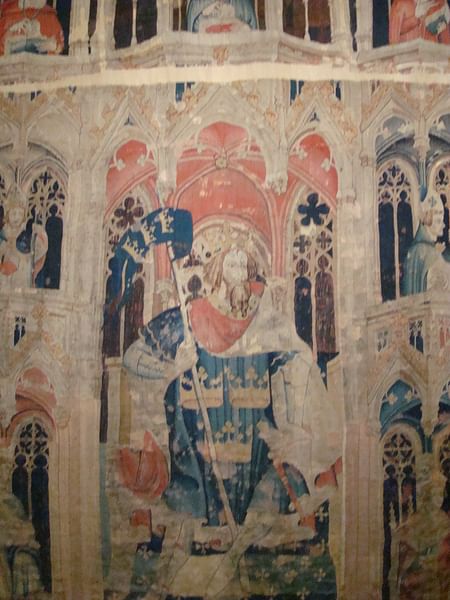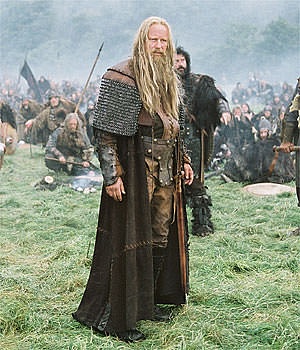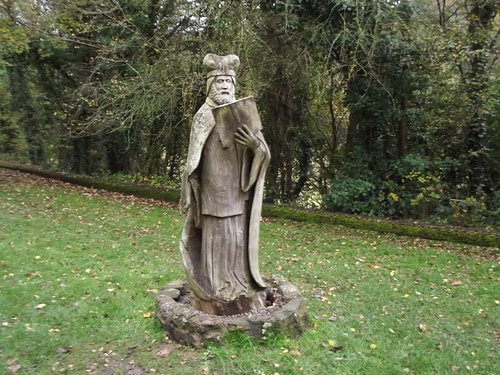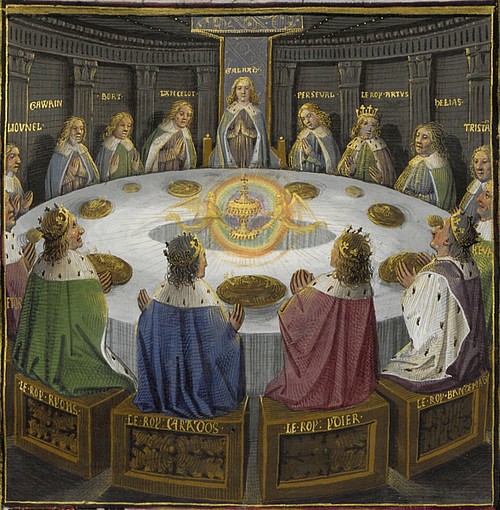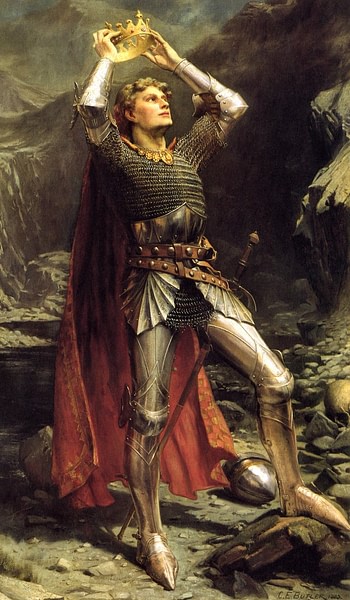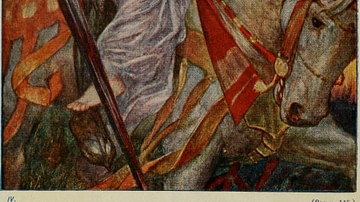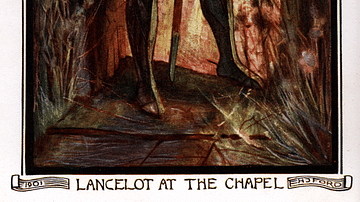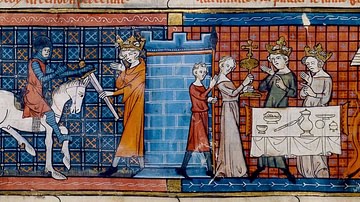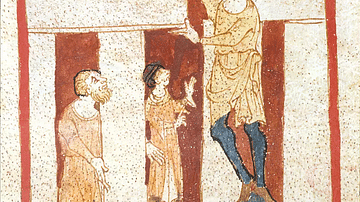The Arthurian legend begins with the Welsh cleric Geoffrey of Monmouth (c. 1100 - c. 1155 CE). Earlier history writers such as Gildas, Bede, and Nennius had already established the existence of a British war-chief who defeated the Saxons at Badon Hill long before Geoffrey wrote his own account but none of them would imagine the king so brilliantly or choose to develop history into legend. In the beginning of his History of the Kings of Britain (1136 CE) he explains how he came to write the work:
Oftentimes, in turning over in mine own mind the many themes that might be subject-matter of a book, my thoughts would fall upon the plan of writing a history of the Kings of Britain, and in my musings thereupon meseemed it a marvel that, beyond such mention as Gildas and Bede have made of them in the luminous tractate, nought could I find as concerning the kings that had dwelt in Britain before the Incarnation of Christ nor nought even as concerning Arthur and the many others that did succeed him after the Incarnation, albeit that their deeds be worthy of praise everlasting and be as pleasantly rehearsed from memory by word of mouth in the traditions of many peoples as though they were written down. (3)
This passage introduces the reader to Geoffrey's problem which is solved when a friend of his loans him 'a certain most ancient book' which is exactly what he was hoping for. He then claims that his work is just a translation from this ancient text into Latin. While some scholars claim that it is possible he had access to an actual 'most ancient book,' there is no doubt that Geoffrey made up most of his 'history' in an attempt to give Britain a proud and noble past.
Although the lack of Arthurian literature is Geoffrey's main complaint in the preface, his work does not focus on Arthur solely but on the kings of Britain from the first ruler, Brut (c. 12th century BCE), to Cadwallader (c. 7th century CE). Arthur's story is only told in Books 9, 10, and 11 of the book, but in this short space, Geoffrey creates one of the most powerful epics in literature.
Arthur the Legend
Whatever shortcomings Geoffrey may have had as a history writer he makes up for in style, imagination, and dramatic pacing. Geoffrey's Arthur comes alive on the page from his first introduction as a naive youth to a mature king and conqueror of vast realms. Geoffrey makes skilled use of dialogue, setting, characterization, symbol, and most importantly, pacing; his narrative never lags, and he is careful to avoid bogging a reader down in too much description. It is not surprising that his book became an international bestseller and set the foundation for all future works involving the figure of Arthur.
In Geoffrey's piece, Arthur first takes the form of the legendary hero. His armor and helmet are gold, adorned with the sign of the Virgin, and his weapons are the powerful lance known as Ron and the mighty sword Caliburn. Geoffrey changes the name of Badon Hill to The Battle of the Bath and gives Arthur a specific personal enemy in the Saxon leader Cheldric (later given as Cerdic). The Saxons, in Geoffrey's story, have taken an oath to Arthur as tributaries and, just as quickly, broken it. The great battle, then, is transformed from the defensive stand as given in Gildas, Bede, and Nennius, to an offensive campaign for the welfare of the country and personal honor.
Arthur has god on his side in the form of St. Dubric, Archbishop of Caerlon, who delivers the speech before battle encouraging the Britons to fight and have no fear of death because their actions against the enemy will win them heaven. Although Arthur loses a significant number of men in the battle, he wins the day, personally kills 470 Saxons, and drives Cheldric from the field.
Geoffrey places The Battle of Bath toward the beginning of his narrative on Arthur in Book IX, thus changing the traditional order of Arthur's battles as presented by Nennius, and makes the most spectacular victory associated with Arthur only the beginning of an illustrious reign. He builds from that victory on through the first two chapters of Book XI; by the end, Arthur has conquered Europe and even subdued Rome. Although he is the greatest king of his time, he still remains humble and gracious to his friends and is attentive to the needs of his subjects; these will remain characteristic of Arthur throughout the development of his legend.
Geoffrey is the first to introduce characters who will become integral to the later legends: Guinevere, Merlin, Sir Kay, Sir Bedevere, Sir Gawain, Uther Pendragon, and Mordred. Geoffrey also adds touches like Arthur's lance and sword having names and being especially powerful, Arthur as a mighty but merciful warrior, Mordred's treachery in seizing the kingdom and holding Guinevere, the cataclysmic battle between Arthur and Mordred, Arthur's fatal wounding and departure for the Isle of Avalon, and Guinevere taking the vows of chastity and joining a holy order.
It is for this reason that Geoffrey of Monmouth is referred to as the Father of the Arthurian Legend and the Latin form of his name, Galfridius, defines the texts in the present day. The Arthurian canon is divided into pre-Galfridian (written before him) and Galfridian or Post-Galfridian (those which came after him). Every Arthurian text written after Geoffrey's bears the stamp of his influence for the simple reason that his work was read and admired by the greatest poets of the medieval era.
The French Poets
Geoffrey's work was written in Latin, the literary language of the day, and so needed no translation to be read by literate individuals in other countries. There were many of these who were inspired by Geoffrey's account to produce their own; so many, in fact, that those listed below are only the best-known who added the most famous details.
By c. 1160 CE Geoffrey's work had been copied by Wace (also known as Robert Wace, c. 1110-1174 CE) of Normandy. Wace translated the work into Old French vernacular but provided much more than a simple translation. Wace's poetry elevated the story as well as adding significant details such as the Round Table, where all the knights of Arthur's court were equal, and a more complete image of the king himself. Wace is also responsible for the famous name of Arthur's sword: he changed the name from Geoffrey's Caliburn to Chaliburn which, when it was translated to English, became Excalibur.
The Provencal poet Chretien de Troyes (c. 1130 - c. 1190 CE) of the court of Marie de Champagne (l. 1145-1198 CE, daughter of Eleanor of Aquitaine) added the touches of chivalry, courtly love, the quest for the grail, and one of the most enduring of all Arthurian characters, Sir Lancelot. In Chretien's story Erec and Enide (c. 1170 CE), Lancelot makes his first appearance as a knight of Arthur's court. In the poem Lancelot or the Knight of the Cart (c. 1177 CE), Lancelot is the central character in a story detailing his frustrating attempts to rescue the Lady Guinevere. This story is also the first mention of their famous affair which would inform much of later Arthurian literature. Chretien, like Geoffrey of Monmouth, is also regarded as the Father of the Arthurian Legend for these contributions.
Chretien began a tale of Perceval involving the quest for the Holy Grail and introducing the character of the Fisher King (who would later figure so prominently in the legends) c. 1190 CE but did not live to complete it. It was taken up by another French poet Robert de Boron (12th century CE) who wrote Joseph of Arimathea and Merlin, two tales in verse which develop the quest for the Holy Grail and the figure of the Fisher King.
Robert de Boron also provided the famous sword-in-the-stone (in the Merlin piece) which originally appears as a sword in an anvil. Arthurian scholar Norris J. Lacy notes that Robert de Boron "had partially explained the significance of the objects - the sword represents justice; the stone doubtless symbolizes Christ - thereby establishing Arthur as a defender of the faith and as king by divine right" (536). Later writers would change the anvil to a stone and minimize the Christian symbolism. Although this sword is popularly associated with Excalibur, they are two different weapons.
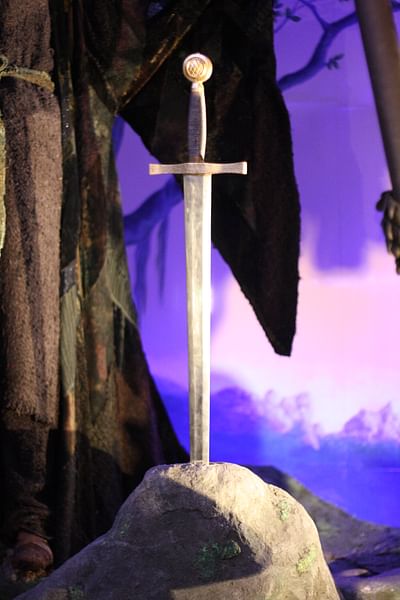
Two other French poets working at this time, Beroul and Thomas of Britain, added their own contributions to the developing legend through their versions of the Tristan and Isolde story in verse. Both of these works are thought to date to c. 1175-1200 CE. Beroul's work lacks the elements of chivalry and courtly love which Thomas of Britain makes ample use of. Thomas of Britain's work is most likely influenced by that of Chretien de Troyes, but the similarities could also be due to the shared interests of their respective audiences who both had a deep interest in these aspects of literary romance: Thomas was writing for Eleanor of Aquitaine and Chretien for her daughter's court.
The French development of the chivalric code of honor and the elements of courtly love are unique in elevating the status of women in European literature to a status they never held before. This has led some scholars (most notably Denis de Rougemont) to suggest a hidden meaning to the tales. De Rougemont and others claim the stories are allegories relating to the Cathar heresy of the 12th and 13th centuries CE. The Cathars venerated a female deity named Sophia (Greek for wisdom), and the plots which involve a damsel in distress generally or Guinevere specifically are symbolic tales illustrating how the church tries to 'kidnap' the ancient wisdom and a noble knight (a Cathar) needs to rescue it and bring it back safely to where it belongs.
The church would eventually suppress the Cathars between 1209-1244 CE but, even before that, the argument goes, the persecution of the Cathars by the church would have made it necessary to conceal their beliefs in the 'coded messages' of romance which only initiates would understand. Whether this is a correct interpretation is still debated but the elements Chretien introduced would influence all the later versions of the Arthurian legend.
The German Poets
The German poet Wolfram von Eschenbach (c. 1170 - c. 1220 CE) took the motif of the quest and created his epic poem Parzival c. 1200 CE in which the central character proceeds on a journey of self-awareness. Wolfram's poem is taken from Chretien's unfinished work and that of Robert de Boron but the characters are more completely developed on every level and the depth of the piece has characterized it as a high point in medieval literature generally and Arthurian texts specifically. Wolfram's work would become the basis for Richard Wagner's later opera of the same name.
Gottfried von Strassburg (c. 1210 CE) wrote his Tristan, drawing on the earlier work of Thomas of Britain and Beroul, to create a powerful piece exploring the tension between romantic (courtly) love and personal honor. The love story of Tristan and Isolde and their betrayal of King Mark, although initially having nothing to do with the Arthurian legend, would later be incorporated into it and also influence the depiction of the affair of Lancelot and Guinevere.
The English Poets
The Welsh masterpiece, the Mabinogion, is dated to around this time (c. 1200 CE) although the text only exists in copies from the 14th and 15th centuries CE. The Mabinogion is a collection of tales influenced by the poetry of Chretien de Troyes but relies heavily on Celtic lore and mythology. Two of the tales, especially, would lend themselves to the development of the Arthurian legend. The tale of Culhwch and Olwen depicts Arthur as a powerful king presiding over a magical realm, and The Dream of Rhonabwy presents the dreamworld in which Arthur and Ywain play their board game as infinitely more interesting than the dreamer's actual life.
This world was then brought to life even more fully by Layamon (c. late 12th/early 13th century CE), a priest of Worcestershire, who was the first to translate Arthur's story into English. Layamon's Brut is a poem of a little over 16,000 lines drawing largely on Wace's work but supplemented by others. Layamon introduced the details of the magical birth of Merlin, describes the origin of the Round Table, and provides the more mystical aspects of the legend.
The next development was the creation of the Vulgate Cycle (also known as the Lancelot-Grail Cycle, Prose Lancelot, and Pseudo-Map Cycle) attributed to the Welsh writer Walter Map (c. 1140 - c. 1210 CE). The composition of the Vulgate Cycle is firmly dated to 1215-1235 CE and so Map could not have been the author. The significance of this work is that it tells the Arthurian legend in prose. Prior to this time, romances were written in poetry, and prose was reserved for serious works of history or theology. This is the first fully realized vision of the quest for the grail, Arthur as a Christian king, Lancelot as the great but flawed hero, and Galahad as the knight pure in heart who is granted a vision of the Holy Grail. The Vulgate Cycle was then edited and revised as the version known as the Post-Vulgate Cycle (c. 1240-1250 CE).
The Post-Vulgate Cycle was the primary source for Sir Thomas Malory (c. 1415-1471 CE) who compiled, edited, revised, and added to the legend to create the English prose masterpiece Le Morte D'Arthur c. 1469 CE while imprisoned. Malory's work is the quintessential Arthurian legend as it is recognized in the modern day. It was published in 1485 CE by William Caxton as part of his initiative to place worthwhile literature in the hands of readers through the new device of the printing press. The story was so popular that second and third printings were ordered.
Decline & Revival
Although a bestseller initially, the work fell out of favor during the 16th century CE at the height of the Renaissance. Tales of a medieval English king were no longer fashionable reading as works of classical Greek and Latin writers were again made widely available. The Protestant Reformation of the 15th century CE had opened religious belief to greater freedom of interpretation, and the printing press allowed for a greater dissemination of works which had been lost for centuries. Writers such as Plato, Homer, Aristotle, Cicero, Lucretius, and Virgil became popular among the literate elite and, the legend (known as The Matter of Britain) was forgotten.
English poet Edmund Spenser (1552-1599 CE) attempted to revive the Arthurian tales in his epic allegorical poem The Faerie Queene (c. 1590 CE) but his Arthur is far too perfect to be interesting. In attempting to make King Arthur a model of Christian virtue and strength, Spenser created a flawless character whose faith in God makes him invincible and therefore superhuman. None of the qualities of the character so notable in Geoffrey of Monmouth's work or in Malory's are present in Spenser's. Although The Faerie Queene was well received, it did nothing to encourage an interest in the Arthurian legend and the stories were more or less forgotten until the 19th century CE. Arthurian scholar Debra N. Mancoff writes:
After centuries of neglect, the Arthurian legend was introduced into the repertoire of the British painter as a patriotic allegory. In 1848, the government, upon the suggestion of Prince Albert, requested that William Dyce design and execute a program of frescoes based on the Arthurian legend in the Queen's Robing Room in the new palace at Westminster. Using Malory as his text, Dyce personified the ideal qualities of British manhood in the heroes of the legend and his moral stance foreshadowed Tennyson's interpretation in the Idylls of the King. (Lacy, 28)
Alfred, Lord Tennyson (1809-1892 CE) popularized the legend through his works beginning in 1832 CE with the publication of his poem The Lady of Shallot, continuing with others on the same theme, and most significantly with the 1859 CE publication of Idylls of the King. Tennyson had long been fascinated by the Arthurian legend and the figure of Arthur and reshaped Malory's text, returning the story to poetic form, to reflect the values of Victorian England. Idylls of the King was by no means his final work on the subject, and he would continue to write and publish Arthurian poetry until his death. Tennyson's work inspired other Victorian writers and poets to take up the subject matter themselves and Arthurian literature was reborn in the modern age.
The story of Arthur, the quest, and the Knights of the Round Table again became popular reading material, generated a prose version in modern English (King Arthur and His Knights of the Round Table by James Knowles, published in 1862 CE) and began to be taken seriously by scholars who devoted themselves to interpreting the symbolism and looking into the early sources of the tales. The Arthurian legend became standard reading material for young people and established the code of chivalry and proper conduct for those of all ages.
Tennyson is regularly referred to as the Father of the Arthurian Renaissance as he was almost wholly responsible for reigniting interest in the legend. Mark Twain expanded an audience for Arthur in his A Connecticut Yankee in King Arthur's Court in 1889 CE. In the 20th century CE, writers like T.S. Eliot, Hemingway, Fitzgerald, D. H. Lawrence, and Joyce would draw on the legends for symbolism in their own work. John Steinbeck rewrote the tales for a modern audience and T.H. White redefined the legend for his own time in 1958 CE through his work The Once and Future King.
Thomas Berger would later do the same in his novel Arthur Rex, and Mary Stewart would further popularize the legend through her Merlin Trilogy. These are only a few of the writers and artists who consistently turn to the Arthurian legends for inspiration. People are drawn to the story in the modern day just as they were when Geoffrey first published his work because the character of Arthur is timeless; every age, no matter how sophisticated it feels itself to be, still looks for a hero.
